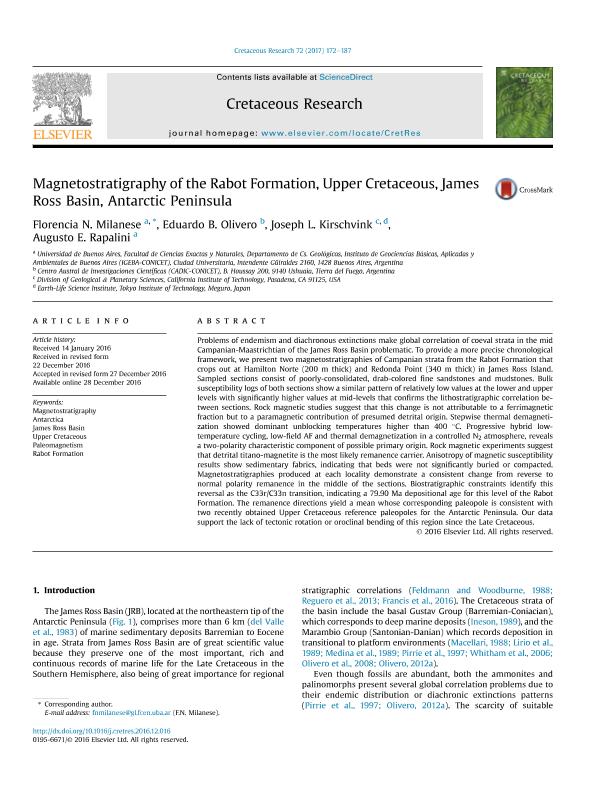Mostrar el registro sencillo del ítem
dc.contributor.author
Milanese, Florencia Nidia

dc.contributor.author
Olivero, Eduardo Bernardo

dc.contributor.author
Kirschvink, Joseph L.
dc.contributor.author
Rapalini, Augusto Ernesto

dc.date.available
2018-11-08T22:20:29Z
dc.date.issued
2017-04
dc.identifier.citation
Milanese, Florencia Nidia; Olivero, Eduardo Bernardo; Kirschvink, Joseph L.; Rapalini, Augusto Ernesto; Magnetostratigraphy of the Rabot Formation, Upper Cretaceous, James Ross Basin, Antarctic Peninsula; Academic Press Ltd - Elsevier Science Ltd; Cretaceous Research; 72; 4-2017; 172-187
dc.identifier.issn
0195-6671
dc.identifier.uri
http://hdl.handle.net/11336/64053
dc.description.abstract
Problems of endemism and diachronous extinctions make global correlation of coeval strata in the mid Campanian-Maastrichtian of the James Ross Basin problematic. To provide a more precise chronological framework, we present two magnetostratigraphies of Campanian strata from the Rabot Formation that crops out at Hamilton Norte (200 m thick) and Redonda Point (340 m thick) in James Ross Island. Sampled sections consist of poorly-consolidated, drab-colored fine sandstones and mudstones. Bulk susceptibility logs of both sections show a similar pattern of relatively low values at the lower and upper levels with significantly higher values at mid-levels that confirms the lithostratigraphic correlation between sections. Rock magnetic studies suggest that this change is not attributable to a ferrimagnetic fraction but to a paramagnetic contribution of presumed detrital origin. Stepwise thermal demagnetization showed dominant unblocking temperatures higher than 400 °C. Progressive hybrid low-temperature cycling, low-field AF and thermal demagnetization in a controlled N2 atmosphere, reveals a two-polarity characteristic component of possible primary origin. Rock magnetic experiments suggest that detrital titano-magnetite is the most likely remanence carrier. Anisotropy of magnetic susceptibility results show sedimentary fabrics, indicating that beds were not significantly buried or compacted. Magnetostratigraphies produced at each locality demonstrate a consistent change from reverse to normal polarity remanence in the middle of the sections. Biostratigraphic constraints identify this reversal as the C33r/C33n transition, indicating a 79.90 Ma depositional age for this level of the Rabot Formation. The remanence directions yield a mean whose corresponding paleopole is consistent with two recently obtained Upper Cretaceous reference paleopoles for the Antarctic Peninsula. Our data support the lack of tectonic rotation or oroclinal bending of this region since the Late Cretaceous.
dc.format
application/pdf
dc.language.iso
eng
dc.publisher
Academic Press Ltd - Elsevier Science Ltd

dc.rights
info:eu-repo/semantics/openAccess
dc.rights.uri
https://creativecommons.org/licenses/by-nc-sa/2.5/ar/
dc.subject
Antarctica
dc.subject
James Ross Basin
dc.subject
Magnetostratigraphy
dc.subject
Paleomagnetism
dc.subject
Rabot Formation
dc.subject
Upper Cretaceous
dc.subject.classification
Meteorología y Ciencias Atmosféricas

dc.subject.classification
Ciencias de la Tierra y relacionadas con el Medio Ambiente

dc.subject.classification
CIENCIAS NATURALES Y EXACTAS

dc.title
Magnetostratigraphy of the Rabot Formation, Upper Cretaceous, James Ross Basin, Antarctic Peninsula
dc.type
info:eu-repo/semantics/article
dc.type
info:ar-repo/semantics/artículo
dc.type
info:eu-repo/semantics/publishedVersion
dc.date.updated
2018-10-19T15:04:30Z
dc.journal.volume
72
dc.journal.pagination
172-187
dc.journal.pais
Países Bajos

dc.journal.ciudad
Amsterdam
dc.description.fil
Fil: Milanese, Florencia Nidia. Consejo Nacional de Investigaciones Científicas y Técnicas. Oficina de Coordinación Administrativa Ciudad Universitaria. Instituto de Geociencias Básicas, Aplicadas y Ambientales de Buenos Aires. Universidad de Buenos Aires. Facultad de Ciencias Exactas y Naturales. Instituto de Geociencias Básicas, Aplicadas y Ambientales de Buenos Aires; Argentina
dc.description.fil
Fil: Olivero, Eduardo Bernardo. Consejo Nacional de Investigaciones Científicas y Técnicas. Centro Austral de Investigaciones Científicas; Argentina
dc.description.fil
Fil: Kirschvink, Joseph L.. Caltech Division Of Geological And Planetary Sciences; Estados Unidos. Tokyo Institute Of Technology; Japón
dc.description.fil
Fil: Rapalini, Augusto Ernesto. Consejo Nacional de Investigaciones Científicas y Técnicas. Oficina de Coordinación Administrativa Ciudad Universitaria. Instituto de Geociencias Básicas, Aplicadas y Ambientales de Buenos Aires. Universidad de Buenos Aires. Facultad de Ciencias Exactas y Naturales. Instituto de Geociencias Básicas, Aplicadas y Ambientales de Buenos Aires; Argentina
dc.journal.title
Cretaceous Research

dc.relation.alternativeid
info:eu-repo/semantics/altIdentifier/url/https://www.sciencedirect.com/science/article/pii/S0195667116304141
dc.relation.alternativeid
info:eu-repo/semantics/altIdentifier/doi/https://doi.org/10.1016/j.cretres.2016.12.016
Archivos asociados
